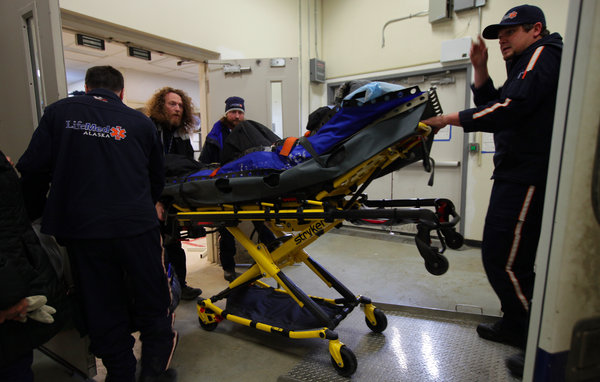
A plane arriving with a patient at the airport in Bethel, Alaska.
BETHEL, Alaska — Americans in some rural places fret at how far away big-city medical help might be in an emergency, or at the long drives they are forced to make for prenatal care, or stitches, or chemotherapy.
Dr. Ellen Hodges only wishes it could be so easy.
She oversees health care for a population of 28,000, mostly Alaska Natives, here in the state’s far west end, spread out over an area the size of Oregon that has almost no roads. People can travel by boat or snow machine at certain times of the year, but not right now: the Kuskokwim River, which wends through Bethel to the Bering Sea, is choked with unstable melting ice in late May, magnifying the isolation that defines everything in what may be America’s emptiest corner.
“If you have a road, you’re not remote,” Dr. Hodges said.
The complex machinery of health care is being reimagined everywhere in the nation through the combined prism of new regulations and shifting economics, even here on the continent’s frosted fringe.
The grandly named Yukon-Kuskokwim Health Corporation, for example, where Dr. Hodges is chief of staff, is scrambling this spring to install a new electronic medical records system. That is a hallmark of the federal health care overhaul, compounded out here by the fact that computers run by generators in far-flung villages are subject to brownouts and fuel shortages.
Cost controls are also the way of the medical frontier no matter where you look. In other places, such constraints may be driven by insurance companies; here, by sequester-driven budget cuts to the federal Indian Health Service. The agency is the 50-bed hospital’s main support in treating the tribes and villagers who have lived for thousands of years in the boggy crescent of lowlands where the Yukon and Kuskokwim Rivers carve their paths to the sea.
The 56 tribes in the region voted in the mid-1990s to bundle their health care money from the federal government to finance the hospital. Grants supplement the work.
But the one thing that shapes every care decision, from the routine to the catastrophic, is the map. Triage in medical decisions, logistics and money is all filtered through an equation of time and distance on a vast and mostly untracked land.
Is air transport justified for medical reasons? Too slow to make a difference? Too dangerous in bad weather to attempt? What should a health worker on the ground — in most villages a local resident trained by the hospital — be told to do, or not do?
“There are judgment calls that you never have to make in the lower 48,” said Dr. David Bielak, 31, a family medicine practitioner who started coming here last fall in temporary stints from his home near San Jose, Calif.
And many of those decisions, often based on telephone descriptions from a villager, can be weighty. None of the more than four dozen communities served by the hospital have a doctor in residence.
“It’s the middle of the night, and you get a call from a clinic way up in the middle of nowhere where something very, very strange has happened,” Dr. Bielak said. “A lot of it is dark: a lot of alcoholism, suicidal ideation, a lot of abuse.”
A lack of running water and sewer systems in many villages in turn compounds the struggle to make, or keep, people well in a place long marked by poverty and isolation.
Take a glimpse, for example, into Alexandria Tikiun’s world: At age 25, with four children at home to care for, she is a community health aide, the closest thing to an M.D. in her village, Atmautluak, population about 400.
The aide system itself is uniquely Alaskan. It was developed in the 1950s, during an outbreak of tuberculosis, when the first health aides were trained to dispense medicine. Now, in sessions here at the hospital, Ms. Tikiun and 150 other aides, mostly women, learn medical skills that include trauma response, pregnancy testing and vaccination, all based on a book that they call their bible, which walks them through a kind of algorithm of step-by-step questions leading to treatment protocols.
1 , 2
This article has been revised to reflect the following correction:
Correction: May 28, 2013
An earlier version of this article misstated the number of tribes that voted in the mid-1990s to bundle their health care money from the federal government to finance a hospital. It was 56, not 58.
